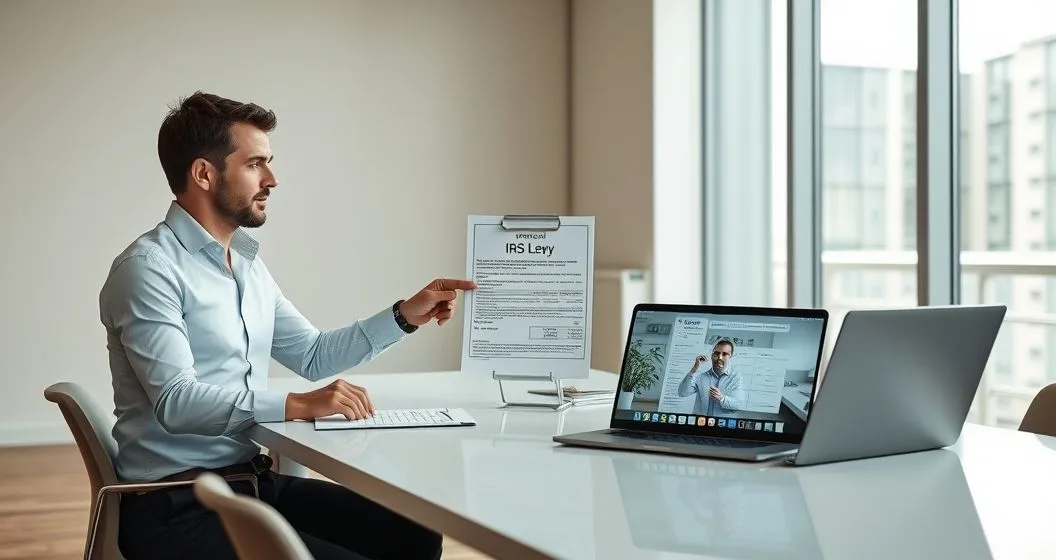Overview
An IRS garnishment for an independent contractor usually comes as a federal tax levy sent to a third-party payer (a client, platform, or agency). The IRS will notify the taxpayer in writing and give a window to resolve the debt or request a hearing; if the matter isn’t settled, the payer may be required to send payments to the IRS instead of the contractor. This can materially affect cash flow for freelancers, gig workers, and small-business owners (IRS.gov).
How the process works — step by step
- Notice first: The IRS sends a notice of intent to levy and explains taxpayer rights and next steps. You typically have 30 days to act or request a Collection Due Process (CDP) hearing (IRS.gov).
- Levy to the payer: If not resolved, the IRS can issue a levy to a third-party payer directing them to withhold future payments for the debt. That levy remains in effect until the debt is paid, released, or legally modified.
- Multiple sources: The IRS can levy multiple payers and payment streams (bank accounts, client payments, marketplace payouts) concurrently.
How much can the IRS take?
There’s no single flat percentage the IRS always takes for contractor payments. Instead, the IRS evaluates the type of payment and the taxpayer’s living expenses. For wage-like payments the IRS uses collection standards to leave money for basic living costs; for other payments, the agency may seize a portion until the liability is satisfied. If you believe the levy amount is excessive, you can explain hardship when you request relief (IRS collection guidance).
Immediate steps to take if you get a Notice of Intent to Levy
- Read the notice carefully and note the deadline to respond.
- Request a Collection Due Process (CDP) hearing or timely appeal within the notice period to pause collection while the appeal is reviewed.
- Contact the IRS to propose an installment agreement, offer in compromise, or request currently not collectible status if you have no ability to pay.
- Get professional representation—an enrolled agent, CPA, or tax attorney can negotiate on your behalf.
- Inform affected clients (briefly and professionally) so they watch for levy paperwork; don’t ask them to withhold payments unless they receive a formal levy.
What clients and payers should know
A payer who receives a levy must comply or risk liability for the funds. Payers should promptly notify the contractor, follow the levy instructions, and consult legal or tax counsel if unsure. If the payer cannot legally withhold (contract terms, escrow rules), they should explain that to the IRS — the agency may work with the payer or release the levy in limited situations (see FinHelp’s guide on how wage garnishments work: How Wage Garnishments Work and How to Stop Them).
Common misconceptions
- “The IRS can’t garnish contractor payments.” False — the IRS can levy payers of contractor income.
- “Paying the debt once will immediately stop the levy.” The levy is generally released after the IRS processes payment or a formal agreement; confirm receipt and get written confirmation of release.
- “Only wages can be garnished.” The IRS can levy many types of payments and accounts; classification depends on the payment source.
Practical tips and strategies
- Keep estimated taxes current. Underpaying estimated tax is a frequent trigger; see the Estimated Tax Payments for Independent Contractors checklist to avoid surprises.
- Maintain clean records of invoices, 1099s, and platform statements — they help during appeals and when negotiating a plan.
- If a levy hits unexpectedly, a short-term installment agreement or a partial payment plan can often stop further enforcement while you stabilize cash flow.
In my practice, contractors who responded within the notice period and proposed a realistic payment arrangement often avoided prolonged levies. Quick action and clear documentation speed the process.
When to get professional help
If the debt is large, the levy affects critical income, or you suspect misclassification or identity theft, consult a tax professional immediately. A representative can request Collection Due Process rights, negotiate installment agreements or offers in compromise, or request a levy release for economic hardship (IRS.gov).
Key resources
- IRS — information on levies and taxpayer rights (IRS.gov)
- Consumer Financial Protection Bureau — debt collection basics (consumerfinance.gov)
Internal resources
- Learn contractor tax basics: Independent Contractor
- Avoid estimated tax shortfalls: Estimated Tax Payments for Independent Contractors
- Learn how wage garnishments work and options to stop them: How Wage Garnishments Work and How to Stop Them
Professional disclaimer
This article is educational and not a substitute for personalized tax advice. For guidance specific to your situation, contact a licensed tax professional or attorney.



